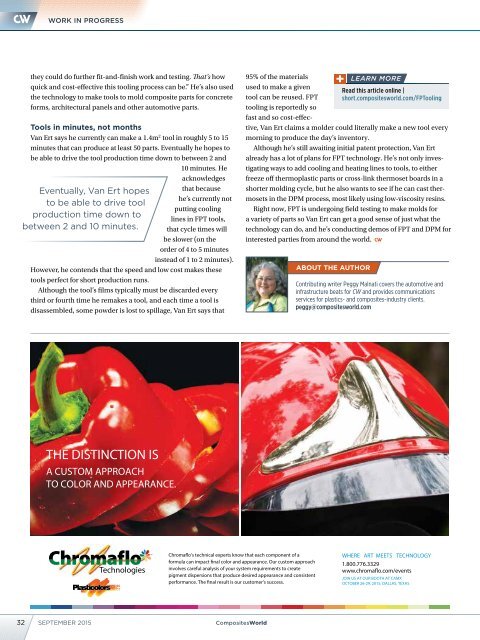FOR AUTO RTM
1VeKpGy
1VeKpGy
Create successful ePaper yourself
Turn your PDF publications into a flip-book with our unique Google optimized e-Paper software.
WORK IN PROGRESS<br />
they could do further fit-and-finish work and testing. That’s how<br />
quick and cost-effective this tooling process can be.” He’s also used<br />
the technology to make tools to mold composite parts for concrete<br />
forms, architectural panels and other automotive parts.<br />
Tools in minutes, not months<br />
Van Ert says he currently can make a 1.4m 2 tool in roughly 5 to 15<br />
minutes that can produce at least 50 parts. Eventually he hopes to<br />
be able to drive the tool production time down to between 2 and<br />
10 minutes. He<br />
acknowledges<br />
Eventually, Van Ert hopes<br />
to be able to drive tool<br />
production time down to<br />
between 2 and 10 minutes.<br />
that because<br />
he’s currently not<br />
putting cooling<br />
lines in FPT tools,<br />
that cycle times will<br />
be slower (on the<br />
order of 4 to 5 minutes<br />
instead of 1 to 2 minutes).<br />
However, he contends that the speed and low cost makes these<br />
tools perfect for short production runs.<br />
Although the tool’s films typically must be discarded every<br />
third or fourth time he remakes a tool, and each time a tool is<br />
disassembled, some powder is lost to spillage, Van Ert says that<br />
Read this article online |<br />
short.compositesworld.com/FPTooling<br />
95% of the materials<br />
used to make a given<br />
tool can be reused. FPT<br />
tooling is reportedly so<br />
fast and so cost-effective,<br />
Van Ert claims a molder could literally make a new tool every<br />
morning to produce the day’s inventory.<br />
Although he’s still awaiting initial patent protection, Van Ert<br />
already has a lot of plans for FPT technology. He’s not only investigating<br />
ways to add cooling and heating lines to tools, to either<br />
freeze off thermoplastic parts or cross-link thermoset boards in a<br />
shorter molding cycle, but he also wants to see if he can cast thermosets<br />
in the DPM process, most likely using low-viscosity resins.<br />
Right now, FPT is undergoing field testing to make molds for<br />
a variety of parts so Van Ert can get a good sense of just what the<br />
technology can do, and he’s conducting demos of FPT and DPM for<br />
interested parties from around the world.<br />
Contributing writer Peggy Malnati covers the automotive and<br />
infrastructure beats for CW and provides communications<br />
services for plastics- and composites-industry clients.<br />
peggy@compositesworld.com<br />
THE DISTINCTION IS<br />
A CUSTOM APPROACH<br />
TO COLOR AND APPEARANCE.<br />
Chromaflo’s technical experts know that each component of a<br />
formula can impact final color and appearance. Our custom approach<br />
involves careful analysis of your system requirements to create<br />
pigment dispersions that produce desired appearance and consistent<br />
performance. The final result is our customer’s success.<br />
WHERE ART MEETS TECHNOLOGY<br />
1.800.776.3329<br />
www.chromaflo.com/events<br />
JOIN US AT OUR BOOTH AT CAMX<br />
OCTOBER 26-29, 2015, DALLAS, TEXAS<br />
32 SEPTEMBER 2015<br />
CompositesWorld


